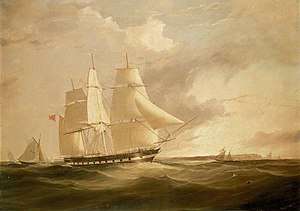Sir George Seymour (1844 ship)
 Ship Sir George Seymour sailing down the Channel with other shipping with the coast in the background. W.T. Howard, National Maritime Museum, Greenwich | |
| History | |
|---|---|
| Namesake: | Sir George Francis Seymour[Note 1] |
| Builder: | Somes Brothers |
| Launched: | 1844 |
| Fate: | Burnt and abandoned 18 December 1867 |
| General characteristics | |
| Tons burthen: | 580 (old), or 872 (new)[1] (bm) |
| Length: | 141 ft 0 in (43.0 m)[1] |
| Beam: | 33 ft 0 in (10.1 m)[1] |
| Depth: | 22 ft 7 in (6.9 m)[1] |
| Notes: | Yellow Metal sheathing |
Sir George Seymour was built in Sunderland, Tyne and Wear in 1844 by Somes Brothers.[2] She made one voyage transporting convicts to Australia and at least one carrying emigrants to Australia and one to New Zealand. A fire at sea in her cargo in December 1867 forced her crew to abandon her.
Convict transport
On 4 November 1844 Sir George Seymour, John Young Clarke, master, set sail from England, bound for Van Diemen's Land, Australia; she arrived at Hobart on 27 February 1845.[3] She had embarked 345 male convicts and she landed 175 at Port Phillip and 169 at Hobart; one convict died on the voyage.[4] She sailed for Calcutta on 27 June with 132 horses, and other cargo and passengers.
1849 emigrant voyage to Australia
Sir George Seymour sailed from Plymouth on 9 January 1849, bound for Geelong, Victoria. She was carrying 302 assisted immigrants and assorted cargo. (Ten vessels, carrying over 1000 immigrants to Australia, left that week.) She anchored off Port Henry on 14 May; she arrived at Melbourne 1 June. On 3 July she sailed from Sydney, bound for Singapore and Calcutta.[5]
1850 emigrant voyage to New Zealand
In 1850 Sir George Seymour was one of the First Four Ships to carry emigrants from England to the new colony of Canterbury in New Zealand on behalf of the Canterbury Association. The other three ships were Cressy, Charlotte Jane, and Randolph.[6]
Sir George Seymour left Plymouth Sound, England around 11am on Sunday, 8 September 1850, with about 227 passengers. She arrived in Lyttelton at 10am on Tuesday, 17 December 1850. The passengers aboard the first four ships were referred to as "The Pilgrims". Their names are inscribed on marble plaques in Cathedral Square in the centre of Christchurch.[7]
Notable passengers
- John Anderson (1820–1897), second mayor of Christchurch[8]
- John Anderson (1850–1934), his son[8]
- Guise Brittan (1807–1876), first Commissioner of Crown Lands for Canterbury[9]
- Emily Foster (1842–1897), teacher and school principal; daughter of Guise Brittan[10]
- Richard James Strachan Harman (1826–1902), politician and businessman[11]
- Henry Jacobs (1824–1901), first Dean of Christchurch[12]
- Elizabeth Watts-Russell (1833–1905), community leader and wife of John Charles Watts-Russell[13]
- John Charles Watts-Russell (1825–1875), politician and runholder[13]
Later career and fate
In 1865 Sir George Seymour underwent repairs for damages. At the time her master was M'Ewen, her owner Higgins & Co., her homeport London, and her trade "Brs".[1]
A fire destroyed Sir George Seymour in 1867. She was carrying a cargo of coal from Liverpool to Bombay when the cargo suffered spontaneous combustion on 18 December 1767 at 25°S 25°W / 25°S 25°W. Her crew abandoned her. Leda, which was on her way to Calcutta, rescued 15 crew members.[14]
Her entry in Lloyd's Register for 1867 carried the annotation "[B]URNT". The listing gave her master as M'Ewen, but her homeport now was Glasgow, and her owner D. Law.[15]
Notes
- ↑ Sir George Francis Seymour (1787–1870), was an Admiral who married Georgina Mary Berkeley, daughter of Admiral Sir George Cranfield Berkeley.
Citations
- 1 2 3 4 5 Lloyd's Register (1865), Seq.№S491.
- ↑ "The ship Sir George Seymour". Royal Museums Greenwich. Retrieved 26 September 2012.
- ↑ Bateson (1959), pp.318–9.
- ↑ Bateson (1959), p.340.
- ↑ National Maritime Museum.
- ↑ "The First Four Ships". Christchurch City Libraries. Retrieved 24 March 2010.
- ↑ "1900: The George Seymour". The Press. January 2006. Retrieved 24 March 2010.
- 1 2 Lowe, Peter. "Anderson, John". Dictionary of New Zealand Biography. Ministry for Culture and Heritage. Retrieved 17 May 2017.
- ↑ Macdonald, George Ranald (1966). "Brittan, William Guise". In McLintock, A. H. An Encyclopaedia of New Zealand. Ministry for Culture and Heritage / Te Manatū Taonga. Retrieved 12 September 2012.
- ↑ Smith, Jo-Anne. "Emily Sophia Foster". Dictionary of New Zealand Biography. Ministry for Culture and Heritage. Retrieved 1 December 2011.
- ↑ Scholefield, Guy, ed. (1940). A Dictionary of New Zealand Biography : A–L (PDF). I. Wellington: Department of Internal Affairs. pp. 358f. Retrieved 6 October 2013.
- ↑ "Death of Dean Jacobs". The Press. LVIII (10884). 7 February 1901. p. 3. Retrieved 30 December 2012.
- 1 2 Smith, Jo-Anne. "Elizabeth Rose Rebecca Watts Russell". Dictionary of New Zealand Biography. Ministry for Culture and Heritage. Retrieved 1 December 2011.
- ↑ "Ship News." Times [London, England 4 Feb. 1868: 9. The Times Digital Archive. Web. 8 Sept. 2018.]
- ↑ Lloyd's Register (1867), Seq.№487.